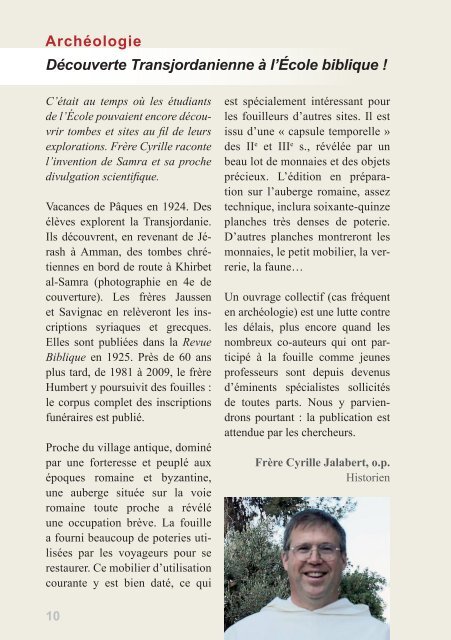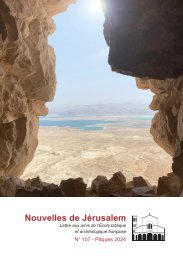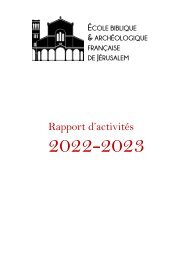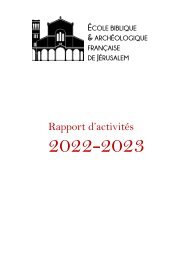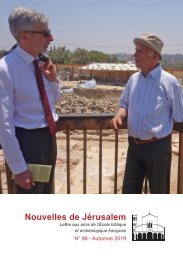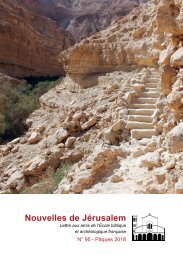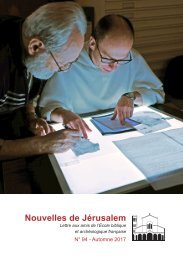Les Nouvelles de Jérusalem - Numéro 105 - Printemps 2023
Découvrez le n°105 des Nouvelles de Jérusalem. Numéro spécial sur la vie académique et l'orientation stratégique de l'École. Les Nouvelles de Jérusalem sont une revue d'informations de l'École biblique et archéologique française de Jérusalem, 2 à 3 fois par an, elles donnent un aperçu des travaux en cours en exégèse comme en archéologie, ici à Jérusalem. Les articles alternent français et anglais. Discover the n° 105 of the Nouvelles de Jérusalem. Special issue on the academic life and the strategic plan of the École. The Nouvelles de Jérusalem is an information review of the École Biblique et Archéologique française de Jérusalem, 2-3 times a year, they give an overview of the work in progress in both exegesis and archeology, here in Jerusalem. Articles are sometimes in French sometimes in English.
Découvrez le n°105 des Nouvelles de Jérusalem.
Numéro spécial sur la vie académique et l'orientation stratégique de l'École.
Les Nouvelles de Jérusalem sont une revue d'informations de l'École biblique et archéologique française de Jérusalem, 2 à 3 fois par an, elles donnent un aperçu des travaux en cours en exégèse comme en archéologie, ici à Jérusalem. Les articles alternent français et anglais.
Discover the n° 105 of the Nouvelles de Jérusalem.
Special issue on the academic life and the strategic plan of the École.
The Nouvelles de Jérusalem is an information review of the École Biblique et Archéologique française de Jérusalem, 2-3 times a year, they give an overview of the work in progress in both exegesis and archeology, here in Jerusalem. Articles are sometimes in French sometimes in English.
You also want an ePaper? Increase the reach of your titles
YUMPU automatically turns print PDFs into web optimized ePapers that Google loves.
Archéologie<br />
Découverte Transjordanienne à l’École biblique !<br />
Archaeology<br />
Potter’s skill is inherited<br />
from a multisecular tradition<br />
C’était au temps où les étudiants<br />
<strong>de</strong> l’École pouvaient encore découvrir<br />
tombes et sites au fil <strong>de</strong> leurs<br />
explorations. Frère Cyrille raconte<br />
l’invention <strong>de</strong> Samra et sa proche<br />
divulgation scientifique.<br />
Vacances <strong>de</strong> Pâques en 1924. Des<br />
élèves explorent la Transjordanie.<br />
Ils découvrent, en revenant <strong>de</strong> Jérash<br />
à Amman, <strong>de</strong>s tombes chrétiennes<br />
en bord <strong>de</strong> route à Khirbet<br />
al-Samra (photographie en 4e <strong>de</strong><br />
couverture). <strong>Les</strong> frères Jaussen<br />
et Savignac en relèveront les inscriptions<br />
syriaques et grecques.<br />
Elles sont publiées dans la Revue<br />
Biblique en 1925. Près <strong>de</strong> 60 ans<br />
plus tard, <strong>de</strong> 1981 à 2009, le frère<br />
Humbert y poursuivit <strong>de</strong>s fouilles :<br />
le corpus complet <strong>de</strong>s inscriptions<br />
funéraires est publié.<br />
Proche du village antique, dominé<br />
par une forteresse et peuplé aux<br />
époques romaine et byzantine,<br />
une auberge située sur la voie<br />
romaine toute proche a révélé<br />
une occupation brève. La fouille<br />
a fourni beaucoup <strong>de</strong> poteries utilisées<br />
par les voyageurs pour se<br />
restaurer. Ce mobilier d’utilisation<br />
courante y est bien daté, ce qui<br />
est spécialement intéressant pour<br />
les fouilleurs d’autres sites. Il est<br />
issu d’une « capsule temporelle »<br />
<strong>de</strong>s II e et III e s., révélée par un<br />
beau lot <strong>de</strong> monnaies et <strong>de</strong>s objets<br />
précieux. L’édition en préparation<br />
sur l’auberge romaine, assez<br />
technique, inclura soixante-quinze<br />
planches très <strong>de</strong>nses <strong>de</strong> poterie.<br />
D’autres planches montreront les<br />
monnaies, le petit mobilier, la verrerie,<br />
la faune…<br />
Un ouvrage collectif (cas fréquent<br />
en archéologie) est une lutte contre<br />
les délais, plus encore quand les<br />
nombreux co-auteurs qui ont participé<br />
à la fouille comme jeunes<br />
professeurs sont <strong>de</strong>puis <strong>de</strong>venus<br />
d’éminents spécialistes sollicités<br />
<strong>de</strong> toutes parts. Nous y parviendrons<br />
pourtant : la publication est<br />
attendue par les chercheurs.<br />
Frère Cyrille Jalabert, o.p.<br />
Historien<br />
The archaeologist, the prehistorian<br />
even more, is concerned with un<strong>de</strong>rstanding<br />
how the material he discovers<br />
in his excavations was ma<strong>de</strong>.<br />
With its composition of pastes, its<br />
mo<strong>de</strong>lling techniques and its firing<br />
methods, traditional Palestinian<br />
pottery offers a useful contribution<br />
to archaeological research.<br />
This craft, now lost, was studied<br />
and photographed in the 1970s by<br />
Owen Rye and the late John Landgraf.<br />
The School recently published<br />
their results in the Cahiers<br />
<strong>de</strong> la Revue Biblique.<br />
In rural workshops, men produced<br />
objects to be sold on a potter’s<br />
wheel. They used very elaborate<br />
techniques, transmitted and perfected<br />
over the centuries by generations<br />
of craftsmen. However, in the<br />
villages of the Palestinian mountains,<br />
a lively tradition of women<br />
potters continued up until 1980, but<br />
then abruptly ceased with the consumer<br />
society. They ma<strong>de</strong> all the<br />
domestic dishes by hand, from the<br />
coil without the wheel, and fired<br />
them without a closed kiln. Their<br />
skill and techniques were exactly<br />
those of 5500 years ago. However,<br />
this pottery appeared in Palestine in<br />
the 14th century with the nomads<br />
forced by the Mamelukes to settle<br />
down. By tradition, they did not<br />
make pottery. The women would<br />
have reinvented the ol<strong>de</strong>st technology<br />
that was then maintained till<br />
the twentieth century. The study is<br />
fundamental to un<strong>de</strong>rstand primitive<br />
pottery.<br />
Fr. Cyrille Jalabert, OP,<br />
Fr. Jean-Baptiste Humbert, OP<br />
Historian, Archeologist<br />
10 <strong>Nouvelles</strong> <strong>de</strong> Jérusalem - N° <strong>105</strong> - Pâque <strong>2023</strong>


